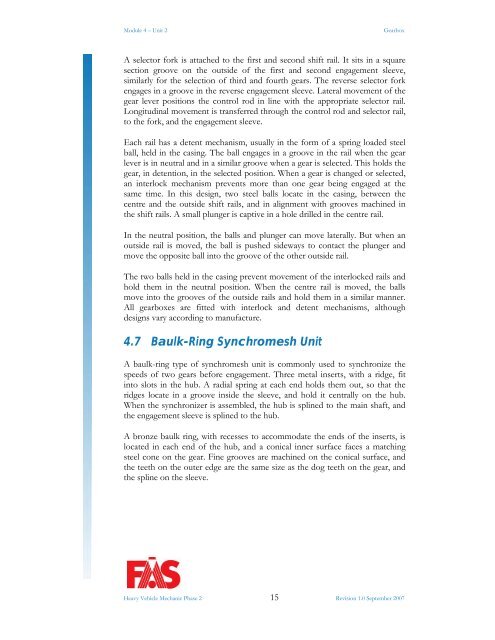TRADE OF HEAVY VEHICLE MECHANIC - eCollege
TRADE OF HEAVY VEHICLE MECHANIC - eCollege
TRADE OF HEAVY VEHICLE MECHANIC - eCollege
Create successful ePaper yourself
Turn your PDF publications into a flip-book with our unique Google optimized e-Paper software.
Module 4 – Unit 2 Gearbox<br />
A selector fork is attached to the first and second shift rail. It sits in a square<br />
section groove on the outside of the first and second engagement sleeve,<br />
similarly for the selection of third and fourth gears. The reverse selector fork<br />
engages in a groove in the reverse engagement sleeve. Lateral movement of the<br />
gear lever positions the control rod in line with the appropriate selector rail.<br />
Longitudinal movement is transferred through the control rod and selector rail,<br />
to the fork, and the engagement sleeve.<br />
Each rail has a detent mechanism, usually in the form of a spring loaded steel<br />
ball, held in the casing. The ball engages in a groove in the rail when the gear<br />
lever is in neutral and in a similar groove when a gear is selected. This holds the<br />
gear, in detention, in the selected position. When a gear is changed or selected,<br />
an interlock mechanism prevents more than one gear being engaged at the<br />
same time. In this design, two steel balls locate in the casing, between the<br />
centre and the outside shift rails, and in alignment with grooves machined in<br />
the shift rails. A small plunger is captive in a hole drilled in the centre rail.<br />
In the neutral position, the balls and plunger can move laterally. But when an<br />
outside rail is moved, the ball is pushed sideways to contact the plunger and<br />
move the opposite ball into the groove of the other outside rail.<br />
The two balls held in the casing prevent movement of the interlocked rails and<br />
hold them in the neutral position. When the centre rail is moved, the balls<br />
move into the grooves of the outside rails and hold them in a similar manner.<br />
All gearboxes are fitted with interlock and detent mechanisms, although<br />
designs vary according to manufacture.<br />
4.7 Baulk-Ring Synchromesh Unit<br />
A baulk-ring type of synchromesh unit is commonly used to synchronize the<br />
speeds of two gears before engagement. Three metal inserts, with a ridge, fit<br />
into slots in the hub. A radial spring at each end holds them out, so that the<br />
ridges locate in a groove inside the sleeve, and hold it centrally on the hub.<br />
When the synchronizer is assembled, the hub is splined to the main shaft, and<br />
the engagement sleeve is splined to the hub.<br />
A bronze baulk ring, with recesses to accommodate the ends of the inserts, is<br />
located in each end of the hub, and a conical inner surface faces a matching<br />
steel cone on the gear. Fine grooves are machined on the conical surface, and<br />
the teeth on the outer edge are the same size as the dog teeth on the gear, and<br />
the spline on the sleeve.<br />
Heavy Vehicle Mechanic Phase 2 15 Revision 1.0 September 2007
















